Geoff Nicholson's Blog, page 47
February 25, 2017
BURNING STILL
Meanwhile in Hollywood, walking under the freeway, we still feel the bern, even as we feel a bit ripped.
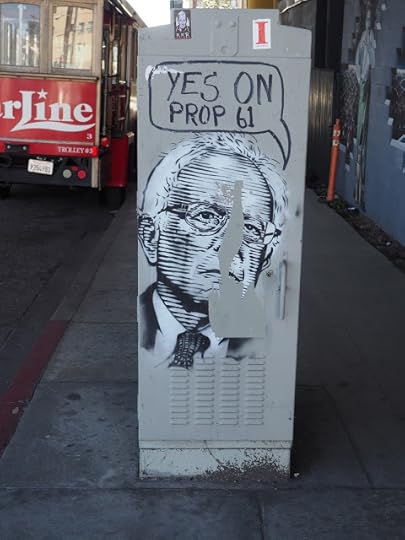



Published on February 25, 2017 12:34
February 20, 2017
WALKING AMONG THOMASSONS
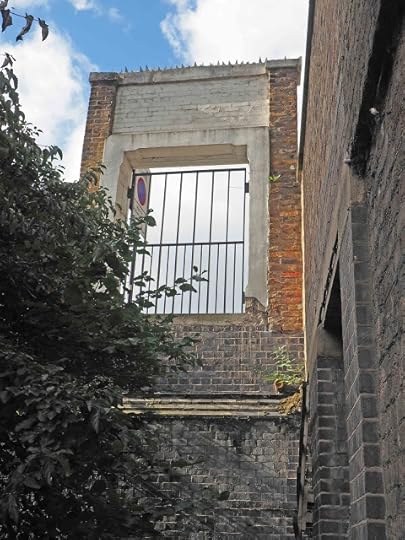
If the Internet has taught us anything it’s that we’re seldom alone in our passions and obsessions. However apparently singular and obscure your interests, somebody somewhere almost certainly shares it. Chances are too that somebody has already set up Facebook and Instagram groups and is organizing seminars and conferences on the subject, maybe walking tours as well.
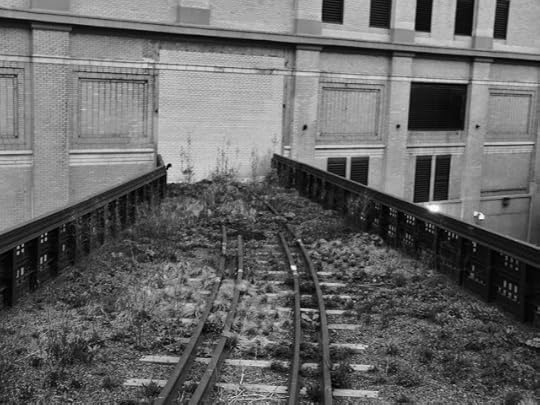
This is reassuring in some respects, but occasionally disappointing in others, in a “Oh, I’m not nearly as special as I thought I was” kind of way. And so we come to the Thomasson, a term I’d never heard until a few weeks ago.
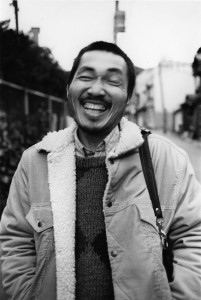
It was invented in the 1970s by the Japanese artist Genpei Akasegawa (above, seems a cheerful fellow) who taught a course in “Modernology” to students in Tokyo. He noticed that in modern cities there are various architectural features, remnants, that no longer serve the purpose for which they were built. In fact they often serve no useful purpose whatsoever, and yet they remain a part of the environment, sometimes ignored, sometimes vaguely repurposed, but often surprisingly well looked-after as a kind of art object.

We’re talking about staircases that don’t lead anywhere, doors that open into fresh air up on the second or third stories of buildings, bricked in gateways, the remains of cut down telephone poles, bridges to nowhere, inaccessible balconies, and there’s the Atomic Thomasson – the silhouette left by a building that’s no longer there, as if it had been obliterated by a nuclear blast.
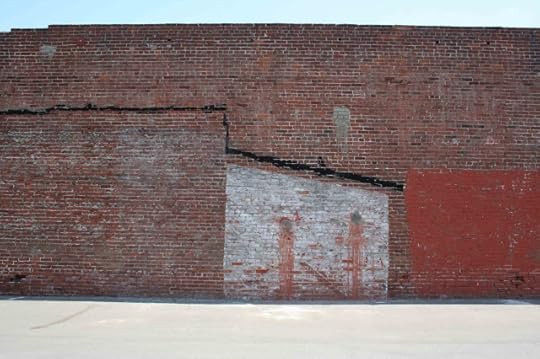
In some ways the Thomasson is a kind of folly, although in other ways it seems to be the opposite of a folly, since a folly is designed specifically to be useless or at least decorative, but the Thomason was originally designed to be useful but has somehow lost its way and become an aesthetic artifact.
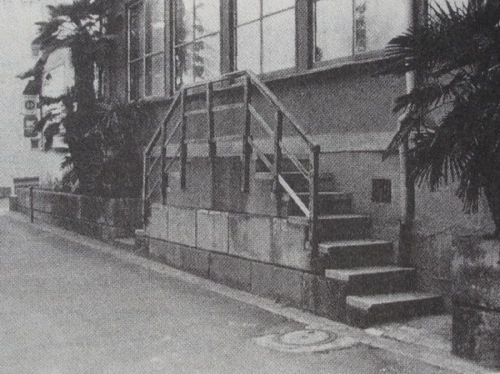

It also has something in common with a ruin. Genpei Akasegawa is especially taken with freestanding chimneys, which remain even after the buildings they served have disappeared. But these are not precisely ruins since they’re intact and potentially usable, but nobody has any use for them.
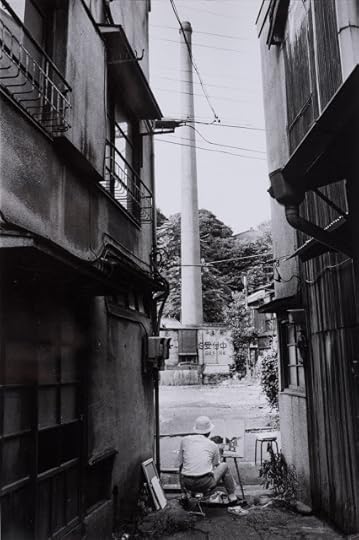
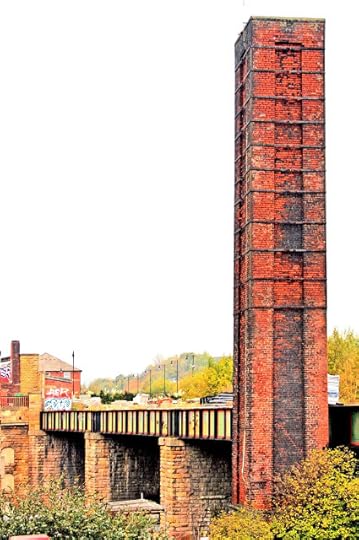
Genpei Akasegawa formalized and discussed these matters at length in a book titled, in English, Hyperart: Thomasson, a collection of essays that had first appeared in the Japanese magazine Photography Times. It’s a rum old book that sometimes seems to take itself too seriously, sometimes not nearly seriously enough, but his description of Thomassons as “schisms in man-made-space, appearing along a fault line of a city’s architecture” seems fair enough.
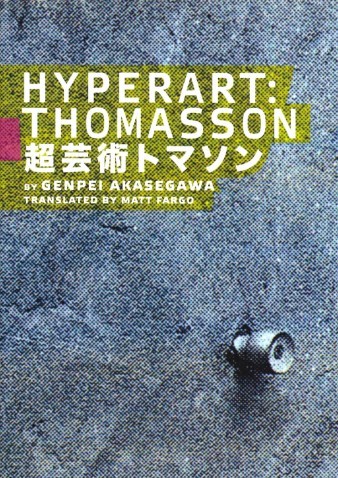
The name comes from the American baseball player Gary Thomasson, who in 1980 was signed to the Yomiuri Giants in Japan for a huge amount of money. He was supposed to be a slugger, a big home run hitter, but he proved to be quite useless. To be honest I do think this is a bit hard on poor old Gary Thomasson. I mean, it’s not like he was trying to be useless, he wanted to hit the ball out of the park, he just happened to keep missing it.
 I realize now that I’ve been noticing and appreciating Thomassons for most of my life, and sometimes I’ve photographed them, despite never knowing there was a name for them. I’ve been sent back to my photography files to look for appropriate pictures but also, perhaps more importantly, when I walk, and not only in the city, I now find myself looking for flaws, looking for Thomassons, with a brand new intensity.
I realize now that I’ve been noticing and appreciating Thomassons for most of my life, and sometimes I’ve photographed them, despite never knowing there was a name for them. I’ve been sent back to my photography files to look for appropriate pictures but also, perhaps more importantly, when I walk, and not only in the city, I now find myself looking for flaws, looking for Thomassons, with a brand new intensity. 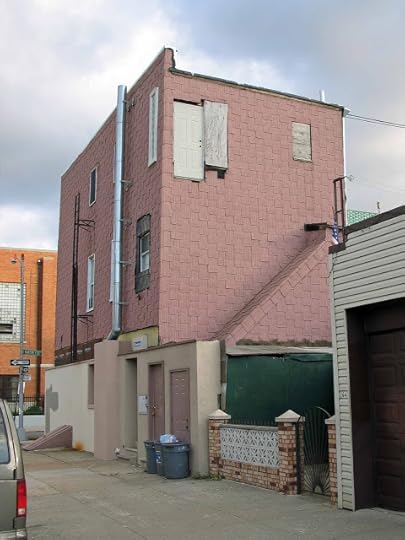
You’ll see examplesfrom my own collection of Thomasson pictures scattered around this article (they’re the ones in color, the black and white come via Genpei Akasegawa), I’m especially fond of steps to nowhere, but I can’t imagine I’ll ever find anything quite as wonderful as the Thomasson on the cover of Genpei Akasegawa’s book, it appears inside too, a door handle stranded in the middle of wall.
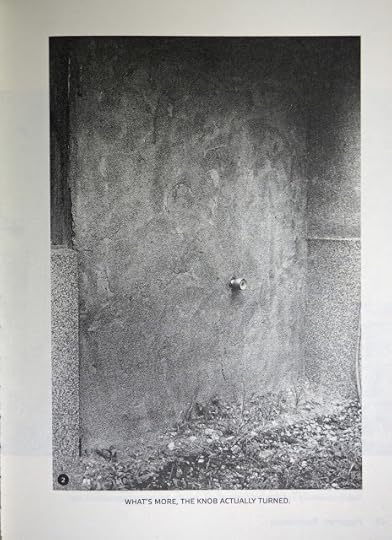
It’s easy enough to imagine that somebody might want to closed off a doorway, in which case you might brick it up and plastered over it, (this one is behind concrete, apparently) but why on earth would you leave a door handle sticking out? And if the in the caption is to be believed, the handle actually turns.
Genpei Akasegawa gives a detailed explanation of how, when and where this Thomasson was found (not by him, and it’s a drycleaner’s) and I want to believe him, but I think there’s at least a possibility that this is an installation, a work of art created by him or somebody else. You know what artists are like.

Published on February 20, 2017 12:06
February 17, 2017
THE DANGERS OF TODDLING
I think this may be a highpoint of the cartographer's art (it shows part of Victorville, California):




Published on February 17, 2017 09:13
February 16, 2017
WALKING AND DRINKING AGAIN, AGAIN

Boy, that movie The Lost Weekend (1945, directed by Billy Wilder), is a hard one to watch these days. I just saw it again on Turner Classic Movies and by the end I really needed a drink. The real problem, I think, is Ray Milland as the hero Don Birnam (I think that’s a reference to Macbeth – author of the novel on which the movie was based - Charles Jackson - was nothing if not high-toned). Milland’s pereformance is all sweaty, eye-rolling, scenery-chewing hamminess. Naturally, he won an Oscar for best actor (he might certainly have won for mostacting).
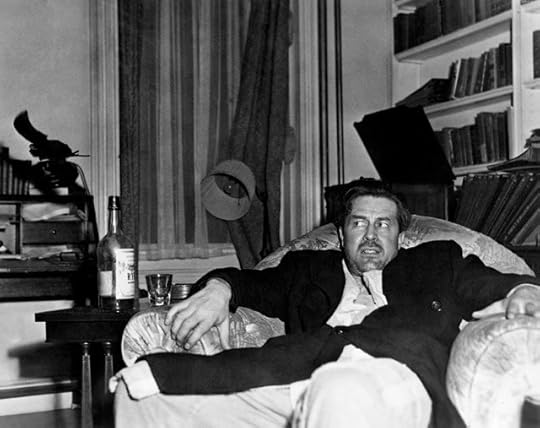
Another, insurmountable, problem is the premise that the hero’s drinking problems stem from writer’s black, from the fact that he’s a failed writer, a man who can barely start, much less finish a project. At the end of the movie it appears he’s going to get his act together and knuckle down and complete his novel. Oh yeah, that’ll solve all his problems.
Still, the movie does have various localized pleasures, not least the scene when Birnam takes a long, desperate walk through Manhattan, trying to find a place to pawn his typewriter for cash.
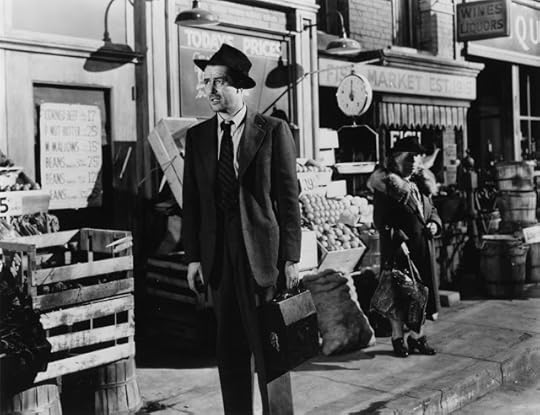
We know from internal evidence in the movie that Birnam lives within easy walking distance of PJ Clarke’s Saloon on Third Avenue at East 55th Street, a real location, still in existence when I last heard, although they had to build a replica in Hollywood to complete the film.

He walks north, and we see a sign forThird Avenue and 75th Street

Then 3rd and 90th.

He certainly walks further than that though the movie isn’t absolutely clear how far, but eventually he gets the news that all the pawn shops are closed – it’s Yom Kippur – a Jewish holiday and the Irish pawn shows are closed too, in solidarity. The Jewish pawn shops reciprocate by closing on St Patrick’s Day.
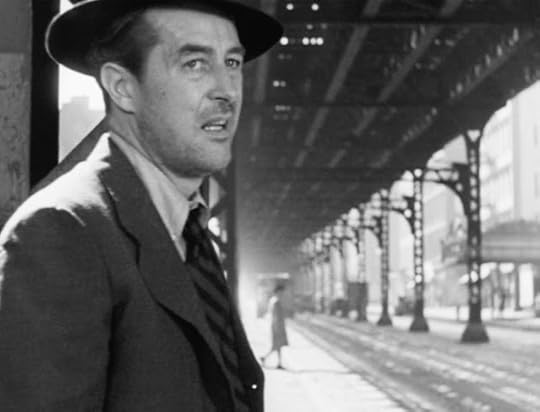
Birnham then walks back down through the city eventually returning to the bar, may hours later, where the bartender gives him just one free drink then kicks him out.
I found myself turning to the book of The Lost Weekend, which I read so long ago I’d pretty much forgotten everything about it. It seems that the movie is about as faithful as any movie ever is. Our hero is a man of the crowd, “How many mornings such as this, mornings in other cities as well as New York, had he taken such walks? Mornings when he truly didn’t know if he was going to give way in a faint after the next step, much less before he reached his destination – liquor store, pawnshop, bar, bed. Mornings of preposterous, inexplicable panic …”
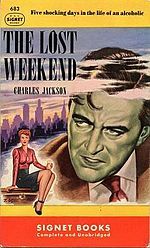
The walk to pawn the typewriter is in there, and it’s a really showy, literary walking/psychogeography setpiece, though it’s different from the movie in several ways – not least in that Birnam walks up 2nd Avenue, not 3rd. Did Jackson know something pan shops that Billy Wilder didn’t, or vice versa? And he goes as far as 120th Street before retuning via First Avenue. As in the movie somebody does explain to him that it’s Yom Kippur, but the joke about the Irish pawn brokers isn’t there.
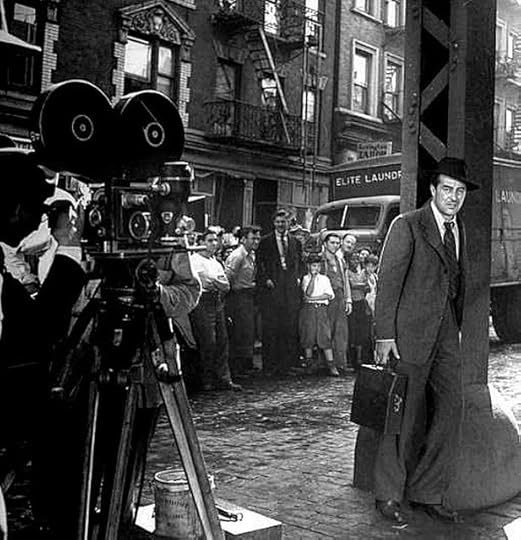
Jackson really pulls out all the stops as he describes the New York street scenes, “The cigars, the glass shops, the hamburger joints, the cafeterias, the news-stands, the dishes in bushel baskets, dishes for sale; the Ruppert brewery stretching from 92ndto 93rd, looking timeless and European, like something you checked in the Baedeker and went around to see; the hardware, the framers, the upholsterers, the haberdashers, the key shops (Keys Made), the moving and trucking, the Soda and Candy, the dairies; the stockings set up on the sidewalks (the tables and tables of boxes and boxes of stockings); the chi-chi horror of the flea-markets; the milk-bars, the orange-juice stands, the weighing-machines, the gaping, smielly dead fish ..” It goes on and on.
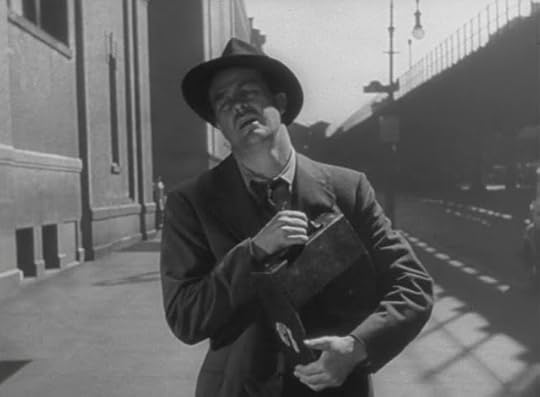
Charles Jackson was described by Donna Rifkind in the New York Times as “one of the most successful failures in American letters.” It was in her review of Farther and Wilder, a biography of Jackson by Blake Bailey’s. She describes how Jackson blamed his mother for his alcoholism, and also for his homosexuality. His mother said of his early work, “I don’t see anything so wonderful about it, it all happened, all you had to do is write it down.” Thanks mom. That doesn’t sound like the very best reason for drinking, but I can see how it might be a reason to have writer’s block.

Published on February 16, 2017 13:18
February 10, 2017
THE DUKES OF AMBOY
Possibly you’ve never been to Amboy, in the Mojave desert. If you’re heading to 29 Palms from Primm or Needles then you’re likely to pass through it. If not, not. It’s one of those desert towns in private hands that comes up for sale once in a while. I’m always tempted.
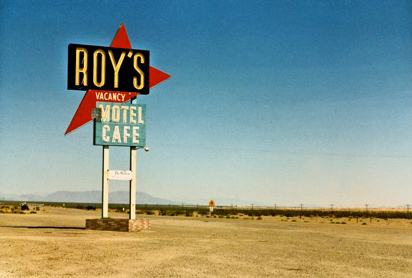
But even if you haven’t been there there’s a chance you may have seen it in the movies (not least the Rutger Hauer version of The Hitcher) or in photographs, not least this one by William Egglestone.
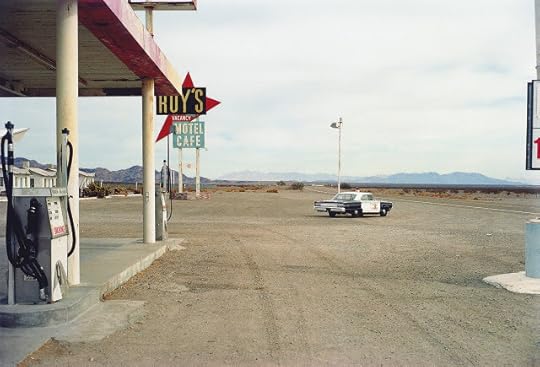
It’s the sign for Roy’s Motel and Café that makes you stop, get out of the car and walk around. I’ve never known the motel to be in business but some of the cabin doors have often been open and this time was a kind of art installation in some of the cabins, going by the name of the Matza Archives:
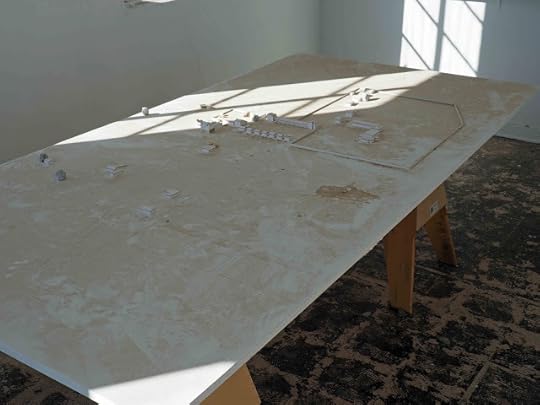
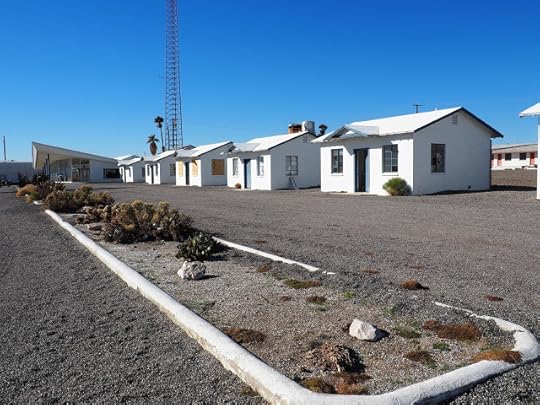
There’s also a school in Amboy, again long out of business, a kind of garage where I have seen evidence of people working on cars, and there’s a post office, and a public toilet which are thriving. I can never tell if they’re really selling gas or not in Amboy, but the café/gift shop is reliably open and I always feel obliged to buy something even if it’s only a soda. This time however I had a treat in store. This Felix the Cat walking sticker:
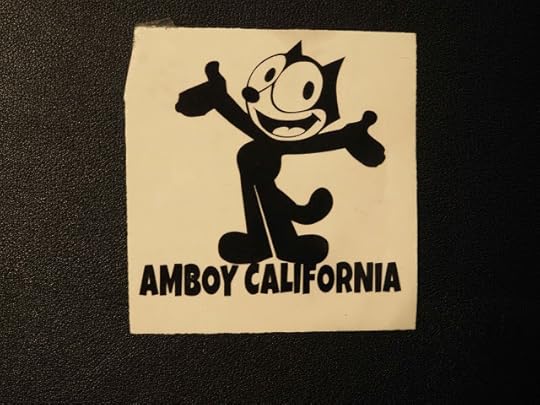
The guy behind the counter said they’d been selling them for a while but they’d been slow movers until they’d had the bright idea of printing Amboy California on the bottom. Works for me either way.
If you’re serious and have 4 hours to spare you can go out of town and clamber up the Amboy Crater, which I have been known to do, and the proof of which is here:
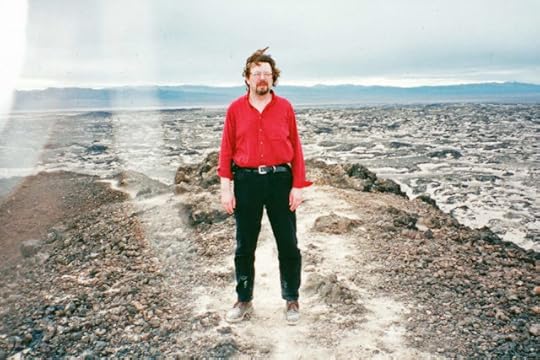


But even if you haven’t been there there’s a chance you may have seen it in the movies (not least the Rutger Hauer version of The Hitcher) or in photographs, not least this one by William Egglestone.

It’s the sign for Roy’s Motel and Café that makes you stop, get out of the car and walk around. I’ve never known the motel to be in business but some of the cabin doors have often been open and this time was a kind of art installation in some of the cabins, going by the name of the Matza Archives:


There’s also a school in Amboy, again long out of business, a kind of garage where I have seen evidence of people working on cars, and there’s a post office, and a public toilet which are thriving. I can never tell if they’re really selling gas or not in Amboy, but the café/gift shop is reliably open and I always feel obliged to buy something even if it’s only a soda. This time however I had a treat in store. This Felix the Cat walking sticker:

The guy behind the counter said they’d been selling them for a while but they’d been slow movers until they’d had the bright idea of printing Amboy California on the bottom. Works for me either way.
If you’re serious and have 4 hours to spare you can go out of town and clamber up the Amboy Crater, which I have been known to do, and the proof of which is here:


Published on February 10, 2017 16:38
February 3, 2017
NO PARTICULAR PLACE TO WALK
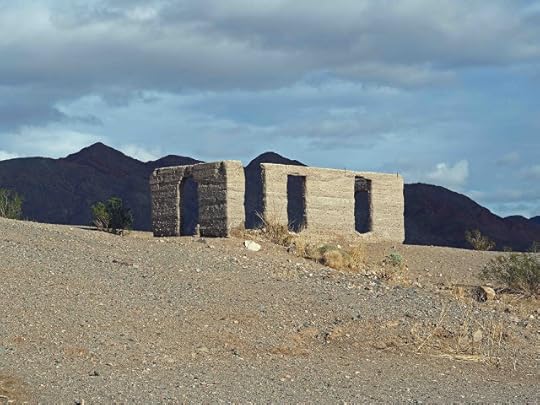
So I went walking in Death Valley last month. It’s something I do every two or three years, and of course I see the ironies of complaining that it gets ever more crowded and less wild each time, but it’s what I do. And I’ve been going there for 30 years, long enough to be able to justify some grumpiness about change and decay.
There was snow on the high ground in Death Valley when I was there this time, and some of the main roads were closed, and some were still washed out from last year, which made the various trails and attractions that were accessible more crowded than ever.Echoing Edward Abbey, I have been known to rail against “industrial tourism,” not least because it reduces vast, diverse landscapes to a series of sites and trails, scenic overlooks, points of interest, and so on. You’re told what to look for; you’re told what to see. Giving these things names – the Devil’s Cornfield, Dante’s View, Zabriskie Point - only adds to the problem. The “attractions” become a kind of checklist that you can tick off and have done with. So yes, visitors flock to these designated sites but more than that, it means that a lot of visitors see nothing except those sites; the 3 million acres of Death Valley are perceived simply as territory you cross on the way to the next attraction. Now, I’m not a complete misanthrope, and when I’m walking in the crowds of New York or London I’m very happy to consider myself part of teeming humanity. But when I’m in the middle of 3 million acres of desert then I think it’s reasonable to want a little space to myself.
But the beauty part of this form of industrial tourism is that if you choose to go somewhere that hasn’tbeen designated as a tourist site then chances are you’ll not see another soul. And so I found myself stopping the car in various unmarked bits of land, pulling off the road and parking, then just walking off into the desert, walking for as long as seemed natural, and then turning around and walking back. I was to say “walking off into some unremarkablebit of desert,” but the fact is, all of Death Valley is remarkable. You’d have to be as insensate as a rock (or a moody adolescent) to set foot in Death Valley and not experience a profound sense of the gorgeously threatening grandeur of the earth.
I ended up here:
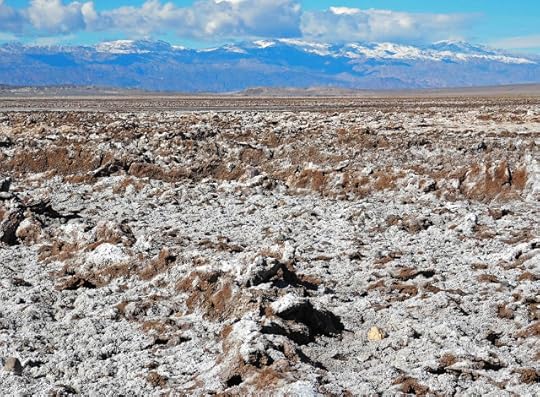
And here:
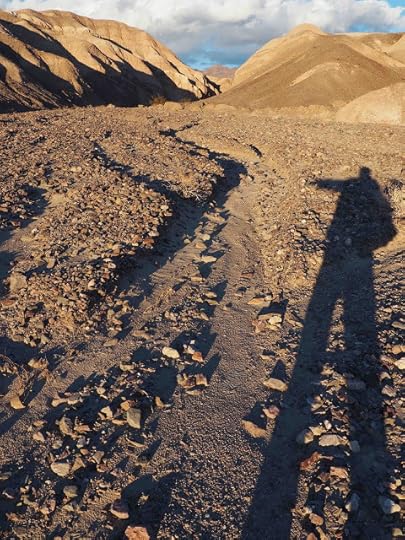
And here:
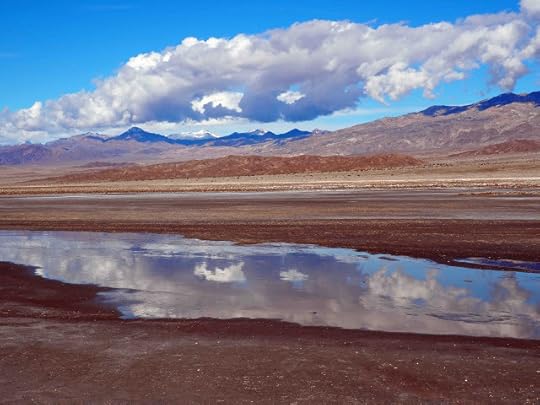
I think I could probably just about find my way back to these places, but maybe I couldn’t, and in any case it doesn’t seem to matter so very much. It is, as they say, all good. The fact that these places don’t have names – Nicholson’s Loop, for instance – is all to the good, if you ask me.
Still, I think there are some questions to be asked about whether a walk needs a destination; and I don’t have an absolute answer. It’s not that I don’t appreciate a good journey’s end, a peak or a ruin or a scenic overview, I do: but they never seem either necessary or sufficient for a good walk. And in my miscellaneous walking this time in Death Valley I did find myself thinking about two lines from the Dylan song Isis “She said where you been?/I said no place special.” But maybe that line doesn’t apply to walking since there’s no such thing as “no place special,” because all places are special one way or another, although that’s not to say that they’re all equal, or equally interesting.
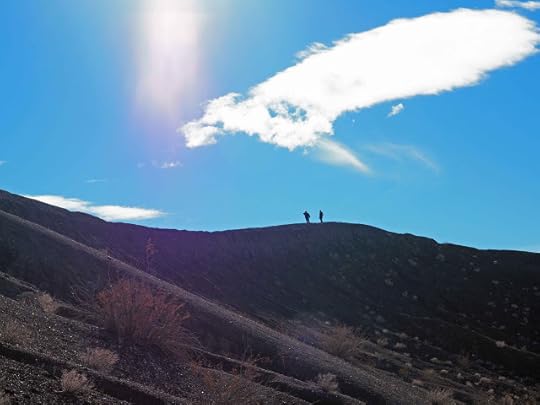
A walk around the rim of a volcanic crater whether alone or in the company of others probably has more going for it than a walk round the parking lot at K-Mart, but that’s no reason only to walk around craters. You can see how a man might tie himself in knots with these matters.
Anyhow, on the way back from Death Valley, coming through Yucca Valley, I did a walk I’d been promising to do for a while, in the Pioneertown Mountains Preserve, which consists of a “modest” 25,500 acres, and the walk was modest too, about two miles in each direction up through Pipes Canyon to something known as the Olson Ruins. The map you pick up at the Ranger station has them as “Olsen Ruins” but most sources have the name as Olson.
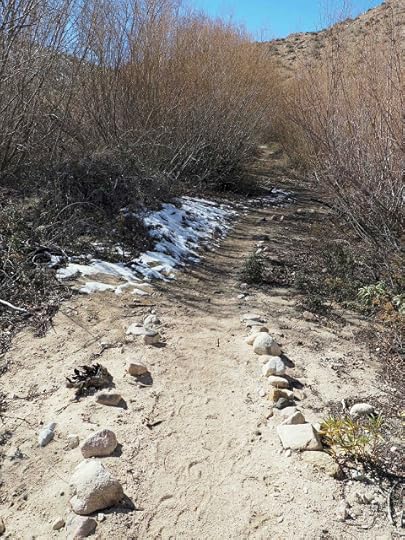
I think you know I like walking in ruins, though I hadn’t done any research about these particular ruins. And so I walked up a clearly marked and perhaps slightly too well kept trail (a ranger told me they had high school “volunteers” to keep it in good condition), past petroglyphs, Joshua Trees that had been burned in the Pioneertown fire some ten years back, past willow beds, through small scattered patches of snow.
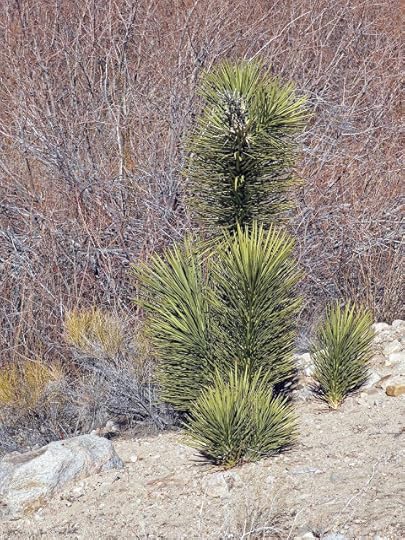
Compared with Death Valley the landscape was tame, and there were one or two other walkers but fewer than you’d have found on any recognized trail in Death Valley.
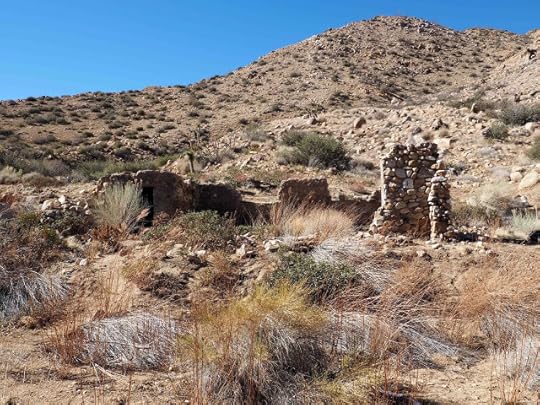
And in due course there were the ruins, picturesque to a degree, and a reasonable journey’s end, but nothing on the grand scale – just somebody’s house, the roof and windows gone, and most of the walls gone too, though there was one room you could actually walk into, that was completely intact, and the corners of the cabin were more or less solid - you could see the chicken wire construction.

As I said, I hadn’t researched the Olson Ruins, but once I got home, I did. The story goes that the cabin belonged to an onyx miner named John Olson who’d been mining since the 1920s. He was still there in 1945 and one day he encountered a young man living rough in the desert, a man in his early 20s (sources seem uncertain about his exact age) named Edward E. Emmery, a soldier recently returned from Burma who had just (oh the irony) deserted from Fort MacArthur.

Olson, in his mid 70s, invited Emmery to stay in the cabin, and conditions must have been crowded, and the two guys must have been in each other’s way. But that doesn’t seem much of an explanation for why, a few days later, Emmery shot Olson and fled the scene, returning to the open desert, taking food from the cabin with him..
Four days later Olson was still alive and was discovered by friends and taken to hospital, but he died there. Emmery was caught a few days after that. Emmery claimed the shooting was accidental, but nobody believed him, and he was charged with murder. I haven’t been able to find out what happened to Emmery.
A cabin makes a good destination for a walk (there are quite a few in Death Valley – and indeed a book about them), a ruined cabin is even better, but a ruined murder cabin – ah, that’s the stuff. I’m sure they’d get more visitors if they named it The Olson Murder Ruins, but I’m very glad they don’t.

Published on February 03, 2017 16:47
NO PARTICUALR PLACE TO WALK

So I went walking in Death Valley last month. It’s something I do every two or three years, and of course I see the ironies of complaining that it gets ever more crowded and less wild each time, but it’s what I do. And I’ve been going there for 30 years, long enough to be able to justify some grumpiness about change and decay.
There was snow on the high ground in Death Valley when I was there this time, and some of the main roads were closed, and some were still washed out from last year, which made the various trails and attractions that were accessible more crowded than ever.Echoing Edward Abbey, I have been known to rail against “industrial tourism,” not least because it reduces vast, diverse landscapes to a series of sites and trails, scenic overlooks, points of interest, and so on. You’re told what to look for; you’re told what to see. Giving these things names – the Devil’s Cornfield, Dante’s View, Zabriskie Point - only adds to the problem. The “attractions” become a kind of checklist that you can tick off and have done with. So yes, visitors flock to these designated sites but more than that, it means that a lot of visitors see nothing except those sites; the 3 million acres of Death Valley are perceived simply as territory you cross on the way to the next attraction. Now, I’m not a complete misanthrope, and when I’m walking in the crowds of New York or London I’m very happy to consider myself part of teeming humanity. But when I’m in the middle of 3 million acres of desert then I think it’s reasonable to want a little space to myself.
But the beauty part of this form of industrial tourism is that if you choose to go somewhere that hasn’tbeen designated as a tourist site then chances are you’ll not see another soul. And so I found myself stopping the car in various unmarked bits of land, pulling off the road and parking, then just walking off into the desert, walking for as long as seemed natural, and then turning around and walking back. I was to say “walking off into some unremarkablebit of desert,” but the fact is, all of Death Valley is remarkable. You’d have to be as insensate as a rock (or a moody adolescent) to set foot in Death Valley and not experience a profound sense of the gorgeously threatening grandeur of the earth.
I ended up here:

And here:

And here:

I think I could probably just about find my way back to these places, but maybe I couldn’t, and in any case it doesn’t seem to matter so very much. It is, as they say, all good. The fact that these places don’t have names – Nicholson’s Loop, for instance – is all to the good, if you ask me.
Still, I think there are some questions to be asked about whether a walk needs a destination; and I don’t have an absolute answer. It’s not that I don’t appreciate a good journey’s end, a peak or a ruin or a scenic overview, I do: but they never seem either necessary or sufficient for a good walk. And in my miscellaneous walking this time in Death Valley I did find myself thinking about two lines from the Dylan song Isis “She said where you been?/I said no place special.” But maybe that line doesn’t apply to walking since there’s no such thing as “no place special,” because all places are special one way or another, although that’s not to say that they’re all equal, or equally interesting.

A walk around the rim of a volcanic crater whether alone or in the company of others probably has more going for it than a walk round the parking lot at K-Mart, but that’s no reason only to walk around craters. You can see how a man might tie himself in knots with these matters.
Anyhow, on the way back from Death Valley, coming through Yucca Valley, I did a walk I’d been promising to do for a while, in the Pioneertown Mountains Preserve, which consists of a “modest” 25,500 acres, and the walk was modest too, about two miles in each direction up through Pipes Canyon to something known as the Olson Ruins. The map you pick up at the Ranger station has them as “Olsen Ruins” but most sources have the name as Olson.

I think you know I like walking in ruins, though I hadn’t done any research about these particular ruins. And so I walked up a clearly marked and perhaps slightly too well kept trail (a ranger told me they had high school “volunteers” to keep it in good condition), past petroglyphs, Joshua Trees that had been burned in the Pioneertown fire some ten years back, past willow beds, through small scattered patches of snow.

Compared with Death Valley the landscape was tame, and there were one or two other walkers but fewer than you’d have found on any recognized trail in Death Valley.

And in due course there were the ruins, picturesque to a degree, and a reasonable journey’s end, but nothing on the grand scale – just somebody’s house, the roof and windows gone, and most of the walls gone too, though there was one room you could actually walk into, that was completely intact, and the corners of the cabin were more or less solid - you could see the chicken wire construction.

As I said, I hadn’t researched the Olson Ruins, but once I got home, I did. The story goes that the cabin belonged to an onyx miner named John Olson who’d been mining since the 1920s. He was still there in 1945 and one day he encountered a young man living rough in the desert, a man in his early 20s (sources seem uncertain about his exact age) named Edward E. Emmery, a soldier recently returned from Burma who had just (oh the irony) deserted from Fort MacArthur.

Olson, in his mid 70s, invited Emmery to stay in the cabin, and conditions must have been crowded, and the two guys must have been in each other’s way. But that doesn’t seem much of an explanation for why, a few days later, Emmery shot Olson and fled the scene, returning to the open desert, taking food from the cabin with him..
Four days later Olson was still alive and was discovered by friends and taken to hospital, but he died there. Emmery was caught a few days after that. Emmery claimed the shooting was accidental, but nobody believed him, and he was charged with murder. I haven’t been able to find out what happened to Emmery.
A cabin makes a good destination for a walk (there are quite a few in Death Valley – and indeed a book about them), a ruined cabin is even better, but a ruined murder cabin – ah, that’s the stuff. I’m sure they’d get more visitors if they named it The Olson Murder Ruins, but I’m very glad they don’t.

Published on February 03, 2017 16:47
February 1, 2017
A WALK IN THE FIRMAMENT
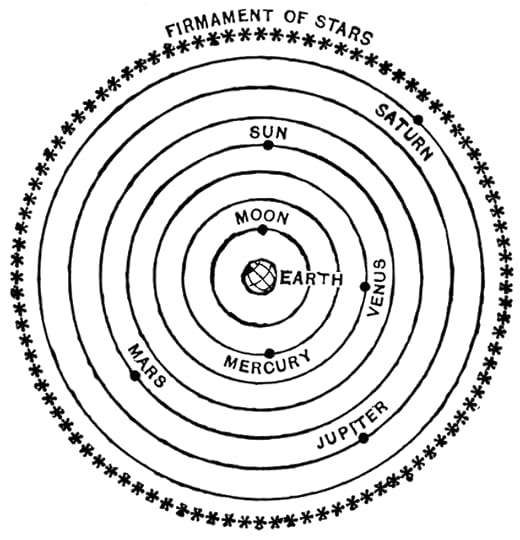
Had you been in Ridgecrest, California on the afternoon of Saturday, January 21styou might well have seen a small group of people walking south down the narrow sidewalk of China Lake Boulevard, occasionally spilling into the road. The group was mostly, but by no means all, women, and one of the walkers appeared (I say appeared because you don’t want to be dogmatic about these things) to be a very tall man in a wig and fishnet stockings. This was, as you’ll have guessed by now, one more anti-Trump demonstration, officially described as the Women's March to Petroglyph Park, followed by a candlelight vigil. The photo below is by Jessica Weston of the Daily independent.
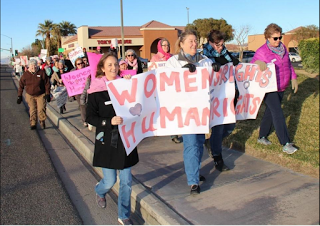
I didn’t join in because I wasn’t sure of the etiquette of some out of town, sis-gendered male infiltrating a women’s march, but I waved and cheered as they went on their way. It was a very good-natured march.
In fact I was going to the Murango Museum, which I knew had the Gladys Merrick Garden, and a labyrinth, but I hadn’t been expecting a “planetary walk” a long outdoor path depicting the solar system, the sun represented by a small football-sized yellow sphere, the other planets represented by spheres of appropriate size and positioned at the proper scale distance from the sun. Pluto (which perhaps they still regarded as a planet: info was thin on the ground) was some two hundred yards away along the path.
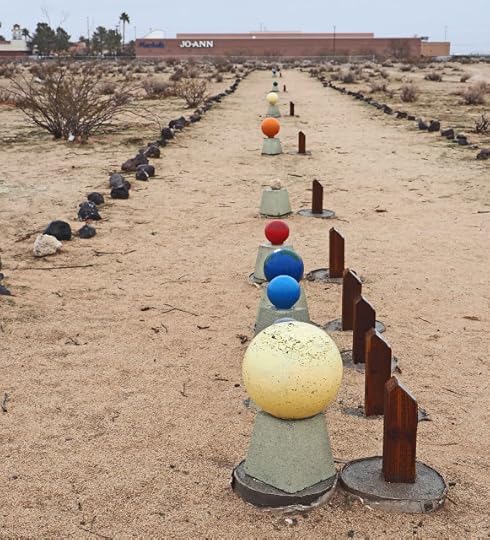
In fact it was cold and raining in Ridgecrest by the time I got to the museum but who could resist a walk to the end of the solar system? You walked out there, past earth:
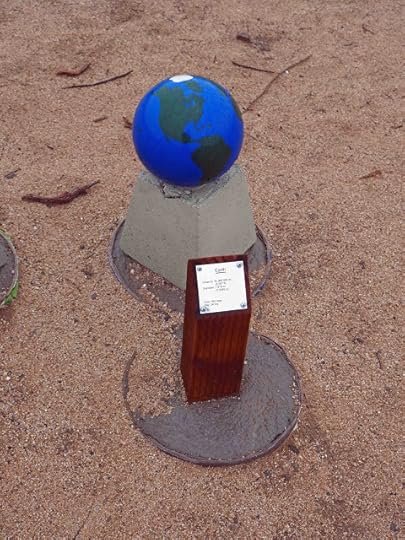
past Saturn:

past all the rest, and when you got to the end (well before you reached the mall with the Marshall and Jo-Ann stores) you looked back across the planets at a now barely visible sun.

You could also make out some white structures related, I think, to astronomical observation; one of which had been burned since I last visited.

I was deeply impressed by this planetary arrangement. I’d never seen or done a planet walk before, though I now gather there are plenty of them about, and many are much longer than the one I did. The walk at the Montshire Museum of Science in Norwich, Vermont, is 1.6 miles long. The one at the Robert Ferguson Observatory in Sonoma is two and a bit, though the latter has the planets set at intervals along a winding trail. The joy of the walk in Ridgecrest is that it’s straight and flat (the way you imagine a diagram of the planets to be).
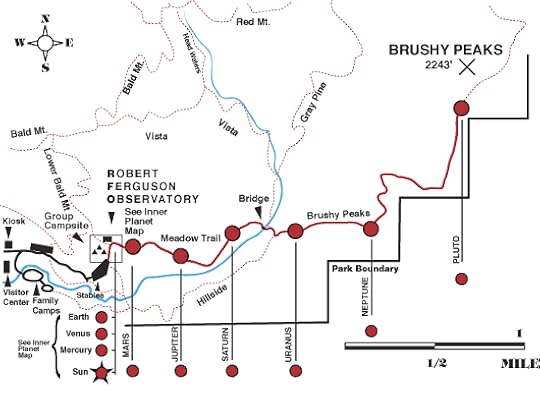
Ridgecrest is on the edge of the Mojave desert, and I often get annoyed by people who describe the desert as a “lunar landscape.” Nevertheless, I dreamed that night that I was walking on the moon. I didn’t have an oxygen tank but I could breath without any problem. There were also trees on the moon, actually bristlecone pines. This picture is by Ansel Adams (but you probably new that).
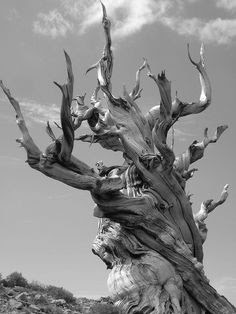
I’d only vaguely heard the name until that day, but there was a photographic exhibition about them in the museum – wonderfully gnarled, twisted things, and they are, by most accounts, the oldest living organisms on earth, some of them about five thousand years old.
I determined that come spring I will make an expedition to the Ancient Bristlecone Pine Forest which is just up the road from Ridgecrest. (It closes for the winter). The bristlecones grow between 5,600 feet, which is not a problem, and 11,200 feet, which makes me think an oxygen tank might be a useful bit of equipment for that part of the hike.

Published on February 01, 2017 10:23
January 20, 2017
WALKING IN WIGS
Here’s some fairly minor walking lore relating to James Burnett, Lord Monboddo (1714-1799), a Scottish judge, linguist, and (I suppose you’d have to say) philosopher, one of the early theorists of evolution. On no obvious scientific basis he posited the notion that men were descended from apes. He’s even mentioned in Martin Chuzzlewick.
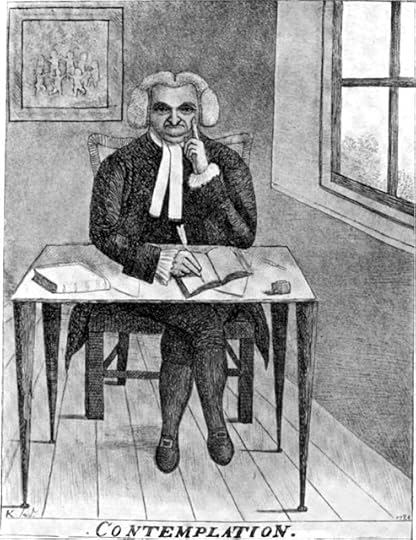
He seems not to have been taken all that seriously by contemporaries. According to a piece in The Herald and Genealogist, Volume the Third, 1866, “it is said that Lord Kames, to whom he would on one occasion have yielded precedence, declined it, saying. ‘By no means, my Lord, you must walk first, that I may see your tail’.”
That's him below on the far right, Lord Kames on far left, Hugo Arnot in the middle: the etching is by John Kay:
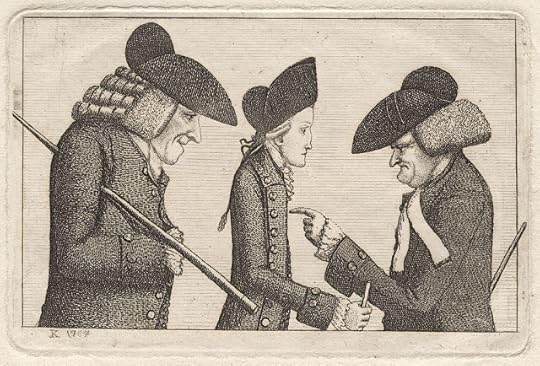
And he's the fellow second from the right in this one:
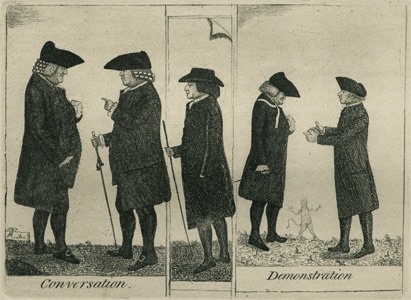
There’s another walking story about Monboddo that I have yet to fully fathom. On one occasion he came out of court to find it was raining. A sedan chair was waiting for him but he declined to use it, calmly placed his wig in the chair, and walked home in the rain. Some sources say this was because he employed the methods of “the ancients” to keep fit, but that hardly seems a complete explanation.
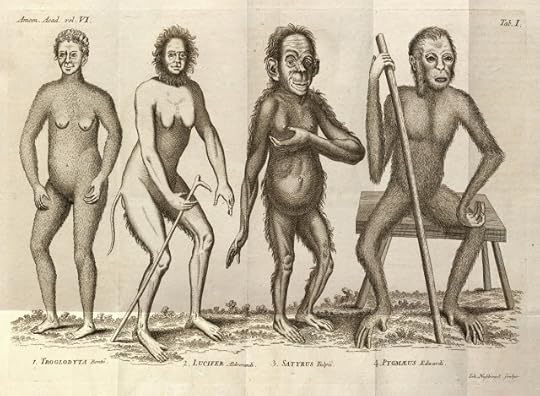


He seems not to have been taken all that seriously by contemporaries. According to a piece in The Herald and Genealogist, Volume the Third, 1866, “it is said that Lord Kames, to whom he would on one occasion have yielded precedence, declined it, saying. ‘By no means, my Lord, you must walk first, that I may see your tail’.”
That's him below on the far right, Lord Kames on far left, Hugo Arnot in the middle: the etching is by John Kay:

And he's the fellow second from the right in this one:

There’s another walking story about Monboddo that I have yet to fully fathom. On one occasion he came out of court to find it was raining. A sedan chair was waiting for him but he declined to use it, calmly placed his wig in the chair, and walked home in the rain. Some sources say this was because he employed the methods of “the ancients” to keep fit, but that hardly seems a complete explanation.


Published on January 20, 2017 11:47
January 17, 2017
IF IT WALKS LIKE A DUCK
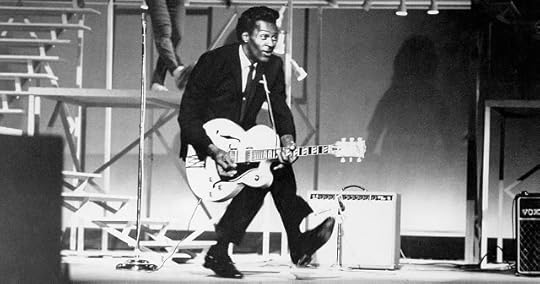
I was listening to variant version of Chuck Berry’s song “Brown Eyed Handsome Man” - sometimes brown-eyed gets hyphenated, and sometimes it doesn’t. It’s an interesting song. As I’m not the first to observe, at this point in history you inevitably hear it as a song about race: he’s really singing about skin color, not eye color. The fact that the song could be a hit in America 1956 is some measure of its double-coding and perhaps of its deniability.

I can’t find a great Chuck Berry live version, but here he is performing the song with Robert Cray:
https://www.youtube.com/watch?v=qg9EdOCE1zI
The lyric that interests us here comes in the second verse
Flying across the desert in a TWA,
I saw a woman walking across the sand
She been a walkin' thirty miles en route to Bombay
To get a brown eyed handsome man
Her destination was a brown eyed handsome man
*Well, Bombay (or Mumbai as we now know it) is of course a pretty good place to find a brown-skinned or indeed brown-eyed man, though I don’t know that there’s a lot of sand in precisely that part of India.
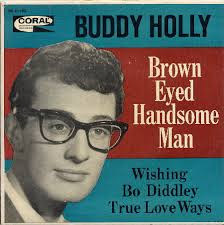
Now, the song has been much covered by people of varying eye and skin color – Buddy Holly, Paul McCartney, Lyall Lovett – they all sang the line about Bombay; but Waylon Jennings in his own countrified version sings it thus, in 1970 – yep he really dressed like that in 1970, but he got over it:
https://www.youtube.com/watch?v=uJ5DlUe8bNE
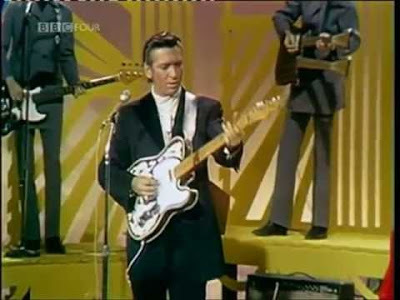

The lyrics in question:Flying cross the desert in a TWA
Saw a woman walking cross the sand
She’s been walking thirty miles en route to L.A. to get
A brown eyed handsome man
The destination was a brown eyed handsome man
Now obviously you get a very different class of brown-eyed man in LA than you do in Bombay, but you’re in with a better chance of finding sand. The song would seem to work perfectly well for a woman, Fontella Bass sang Bombay (it’s a great version), and Tanya Tucker sang LA.
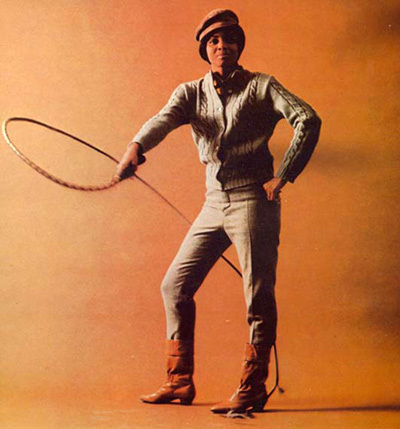
So, a question: did Jennings change the line in the interests of topographic accuracy? Or did he think that walking to Bombay was just too darn exotic, maybe even Orientalist, for his country fans? I’m guessing the latter.

Published on January 17, 2017 17:57
Geoff Nicholson's Blog
- Geoff Nicholson's profile
- 55 followers
Geoff Nicholson isn't a Goodreads Author
(yet),
but they
do have a blog,
so here are some recent posts imported from
their feed.



